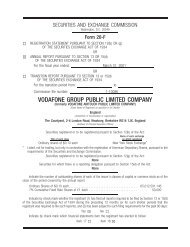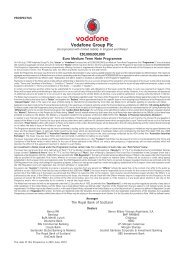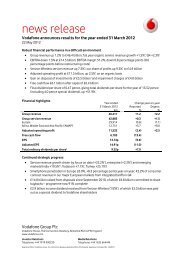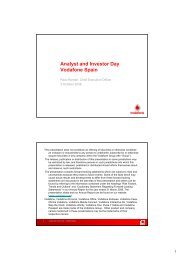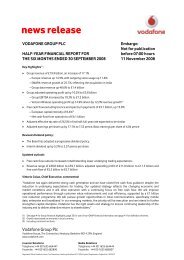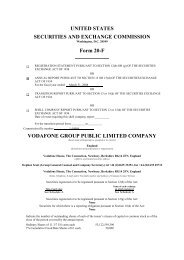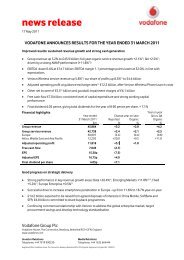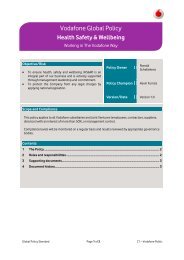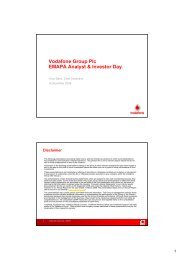You also want an ePaper? Increase the reach of your titles
YUMPU automatically turns print PDFs into web optimized ePapers that Google loves.
Capital market and bank borrowings<br />
Interest bearing loans and overdrafts are initially measured at fair value (which<br />
is equal to cost at inception), and are subsequently measured at amortised cost,<br />
using <strong>the</strong> effective interest rate method, except where <strong>the</strong>y are identified as a<br />
hedged item in a fair value hedge. Any difference between <strong>the</strong> proceeds net of<br />
transaction costs and <strong>the</strong> settlement or redemption of borrowings is recognised<br />
over <strong>the</strong> term of <strong>the</strong> borrowing.<br />
Equity instruments<br />
Equity instruments issued by <strong>the</strong> Group are recorded at <strong>the</strong> proceeds received,<br />
net of direct issue costs.<br />
Derivative financial instruments and hedge accounting<br />
The Group’s activities expose it to <strong>the</strong> financial risks of changes in foreign<br />
exchange rates and interest rates.<br />
The use of financial derivatives is governed by <strong>the</strong> Group’s policies approved by<br />
<strong>the</strong> Board of directors, which provide written principles on <strong>the</strong> use of financial<br />
derivatives consistent with <strong>the</strong> Group’s risk management strategy. Changes in<br />
values of all derivatives of a financing nature are included within investment<br />
income and financing costs in <strong>the</strong> income statement. The Group does not use<br />
derivative financial instruments for speculative purposes.<br />
Derivative financial instruments are initially measured at fair value on <strong>the</strong> contract<br />
date and are subsequently re-measured to fair value at each <strong>report</strong>ing date.<br />
The Group designates certain derivatives as ei<strong>the</strong>r:<br />
•<br />
•<br />
hedges of <strong>the</strong> change of fair value of recognised assets and liabilities<br />
(“fair value hedges”); or<br />
hedges of net investments in foreign operations.<br />
Hedge accounting is discontinued when <strong>the</strong> hedging instrument expires or is sold,<br />
terminated, or exercised, or no longer qualifies for hedge accounting.<br />
Fair value hedges<br />
The Group’s policy is to use derivative instruments (primarily interest rate swaps)<br />
to convert a proportion of its fixed rate debt to floating rates in order to hedge <strong>the</strong><br />
interest rate risk arising, principally, from capital market borrowings. The Group<br />
designates <strong>the</strong>se as fair value hedges of interest rate risk with changes in fair value<br />
of <strong>the</strong> hedging instrument recognised in <strong>the</strong> income statement for <strong>the</strong> period<br />
toge<strong>the</strong>r with <strong>the</strong> changes in <strong>the</strong> fair value of <strong>the</strong> hedged item due to <strong>the</strong> hedged<br />
risk, to <strong>the</strong> extent <strong>the</strong> hedge is effective. The ineffective portion is recognised<br />
immediately in <strong>the</strong> income statement.<br />
Net investment hedges<br />
Exchange differences arising from <strong>the</strong> translation of <strong>the</strong> net investment in foreign<br />
operations are recognised directly in equity. Gains and losses on those hedging<br />
instruments (which include bonds, commercial paper and foreign exchange<br />
contracts) designated as hedges of <strong>the</strong> net investments in foreign operations<br />
are recognised in equity to <strong>the</strong> extent that <strong>the</strong> hedging relationship is effective.<br />
These amounts are included in exchange differences on translation of foreign<br />
operations as stated in <strong>the</strong> statement of recognised income and expense.<br />
Gains and losses relating to hedge ineffectiveness are recognised immediately<br />
in <strong>the</strong> income statement for <strong>the</strong> period. Gains and losses accumulated in <strong>the</strong><br />
translation reserve are included in <strong>the</strong> income statement when <strong>the</strong> foreign<br />
operation is disposed of. During <strong>the</strong> year ended 31 March 2006, <strong>the</strong> Group adopted<br />
<strong>the</strong> Amendments to IAS 21, “The Effect of Changes in Foreign Exchange Rates”,<br />
with effect from 1 April 2004, being <strong>the</strong> date of transition to IFRS for <strong>the</strong> Group.<br />
Put option arrangements<br />
The potential cash payments related to put options issued by <strong>the</strong> Group over <strong>the</strong><br />
equity of subsidiary companies are accounted for as financial liabilities when such<br />
options may only be settled o<strong>the</strong>r than by exchange of a fixed amount of cash<br />
or ano<strong>the</strong>r financial asset for a fixed number of shares in <strong>the</strong> subsidiary.<br />
The amount that may become payable under <strong>the</strong> option on exercise is initially<br />
recognised at fair value within borrowings with a corresponding charge directly to<br />
equity. The charge to equity is recognised separately as written put options over<br />
minority interests, adjacent to minority interests in <strong>the</strong> net assets of consolidated<br />
subsidiaries. The Group recognises <strong>the</strong> cost of writing such put options, determined<br />
as <strong>the</strong> excess of <strong>the</strong> fair value of <strong>the</strong> option over any consideration received,<br />
as a financing cost.<br />
Such options are subsequently measured at amortised cost, using <strong>the</strong> effective<br />
interest rate method, in order to accrete <strong>the</strong> liability up to <strong>the</strong> amount payable<br />
under <strong>the</strong> option at <strong>the</strong> date at which it first becomes exercisable. The charge<br />
arising is recorded as a financing cost. In <strong>the</strong> event that <strong>the</strong> option expires<br />
unexercised, <strong>the</strong> liability is derecognised with a corresponding adjustment<br />
to equity.<br />
Provisions<br />
Provisions are recognised when <strong>the</strong> Group has a present obligation as a result<br />
of a past event and it is probable that <strong>the</strong> Group will be required to settle<br />
that obligation. Provisions are measured at <strong>the</strong> directors’ best estimate of <strong>the</strong><br />
expenditure required to settle <strong>the</strong> obligation at <strong>the</strong> balance sheet date and<br />
are discounted to present value where <strong>the</strong> effect is material.<br />
Share-based payments<br />
The Group issues equity-settled share-based payments to certain employees.<br />
Equity-settled share-based payments are measured at fair value (excluding <strong>the</strong><br />
effect of non market-based vesting conditions) at <strong>the</strong> date of grant. The fair<br />
value determined at <strong>the</strong> grant date of <strong>the</strong> equity-settled share-based payments<br />
is expensed on a straight-line basis over <strong>the</strong> vesting period, based on <strong>the</strong> Group’s<br />
estimate of <strong>the</strong> shares that will eventually vest and adjusted for <strong>the</strong> effect of non<br />
market-based vesting conditions.<br />
Fair value is measured using a binomial pricing model, being a lattice-based<br />
option valuation model, which is calibrated using a Black-Scholes framework.<br />
The expected life used in <strong>the</strong> model has been adjusted, based on management’s<br />
best estimate, for <strong>the</strong> effects of non-transferability, exercise restrictions and<br />
behavioural considerations.<br />
The Group uses historical data to estimate option exercise and employee<br />
termination within <strong>the</strong> valuation model; separate groups of employees that<br />
have similar historical exercise behaviour are considered separately for valuation<br />
purposes. The expected life of options granted is derived from <strong>the</strong> output of<br />
<strong>the</strong> option valuation model and represents <strong>the</strong> period of time that options are<br />
expected to be outstanding. Expected volatilities are based on implied volatilities<br />
as determined by a simple average of no less than three international banks,<br />
excluding <strong>the</strong> highest and lowest numbers. The risk-free rates for periods within<br />
<strong>the</strong> contractual life of <strong>the</strong> option are based on <strong>the</strong> UK gilt yield curve in effect<br />
at <strong>the</strong> time of grant.<br />
Some share awards have an attached market condition, based on Total<br />
Shareholder Return (“TSR”), which is taken into account when calculating <strong>the</strong><br />
fair value of <strong>the</strong> share awards. The valuation for <strong>the</strong> TSR is based on <strong>Vodafone</strong>’s<br />
ranking within <strong>the</strong> same group of companies, where possible, over <strong>the</strong> past five<br />
years. The volatility of <strong>the</strong> ranking over a three year period is used to determine<br />
<strong>the</strong> probable weighted percentage number of shares that could be expected<br />
to vest and hence affect fair value.<br />
The fair value of awards of non-vested shares to <strong>the</strong> Board of directors and<br />
Executive Committee is equal to <strong>the</strong> closing price of <strong>the</strong> <strong>Vodafone</strong>’s shares on<br />
<strong>the</strong> date of grant, as <strong>the</strong>se awards are entitled to dividend equivalents during <strong>the</strong><br />
vesting period. Awards of non-vested shares to o<strong>the</strong>r employees are not entitled<br />
to dividends during <strong>the</strong> vesting period and <strong>the</strong> fair value reflects a discount to <strong>the</strong><br />
closing share price of <strong>Vodafone</strong>’s shares on <strong>the</strong> date of grant equal to <strong>the</strong> present<br />
value of expected dividends to be received over <strong>the</strong> vesting period.<br />
<strong>Vodafone</strong> Group Plc Annual Report 2008 95




